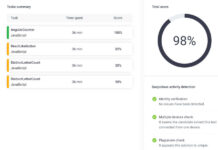
For years, software has been called the future of talent assessment, and there’s no argument that technology is playing a greater role in both screening candidates and matching the right workers with the most appropriate jobs.
With that in mind, we asked Tiffany Green Shortridge, the North American talent assessment leader for Willis Towers Watson’s Saville Assessment, and Jacki Bassani, Willis Towers Watson’s North American leader for talent and rewards, to talk with us about how they see use of such technology progressing.
How does assessment software fit into the overall hiring process? For example, it might test for competencies and values, but at what point do the results pass into human hands and how should they impact the human decision-making?

Tiffany Green Shortridge: Assessments are used to assist hiring managers and recruiters in the selection process to ensure that there is a more fair and standardized way of hiring individuals who are likely to be better performers on the job.
Where the assessment is placed in the selection process is dependent upon the job and the level which we are using assessments for. For example, in high-volume recruitment, assessments should be placed up front in the process and the overall score passed back to recruiters via the applicant tracking system in real time. This is particularly pertinent in a competitive market where quick response times back to applicants can be critical in ensuring employers secure the best talent.
As an alternative, assessments used for selection at the executive level should be put at the back end of the candidate process to assist in determining who the final candidates should be. Here, assessments can be extremely powerful in distinguishing high caliber candidates.
What about after the hire? Obviously, you want every worker to reach their full potential, but HR systems are often isolated from the technology used by other functional areas. Even when that’s not the case, managers may disagree with the system’s assessment. Can you talk about the issues around getting HR and managers onto the same page in terms of talent assessment?
Jacki Bassani: After a candidate is hired, the result of the assessments can be used for developmental purposes via the new managers. This data can give managers an indication of the strengths and developmental areas of a new hire and how the managers can leverage and manage those for improved performance.
Shortridge: If managers are sceptical, it’s critical for HR to demonstrate the value added to selection and development decisions by sharing the improved talent metrics that have been impacted by making better hires via the assessment tool.
Some of these metrics can include sales, performance and retention data. For example, one would expect that candidates receiving higher scores on a sales assessment should have stronger sales metrics once hired, on-boarded and fully trained. Running an ROI study to showcase how higher assessment scores lead to higher business and HR metrics is a great way to show managers the true value of utilizing pre-hire assessments.
Can you see a time when such software is fully integrated into systems elsewhere in the organization, so HR can better track the performance of each hire in a more seamless way?

Bassani: Absolutely. HR eventually needs to get to the place where there is an open platform across all disparate data systems, including the ATS, HRIS, payroll system, training platform, etc. Then, individual and group-level data can be pulled together, synthesized and analyzed to assist HR and the broader organization in finding the stories or impacted outcomes from the data to make faster, smarter business decisions. Data needs to be clean for HR to make sure record-keeping is robust and the decisions made are accurate and defensible.
What do you hear from the marketplace about such systems—not only yours, but others, as well? Also, where are HR departments looking for these systems to make more of a contribution to the hiring and management processes and how would they like it to work?
Shortridge: There is an expectation in the marketplace that assessment systems are agnostic in terms of their ATS integration so that assessment providers are able to integrate with any and all ATS providers.
Bassani: By being fully integrated across the assessment and ATS platforms, organizations are able to streamline their hiring process so assessment scores are passed back in real time to make faster hiring decisions. This can also increase efficiencies further where talent pools can be created and streamed across other roles or jobs that the applicant may be better-suited for based on their skills and traits, but may not have initially applied for.
What about hiring managers? Do they want more access to these tools? And if they do, how does HR feel about it?
Bassani: Hiring managers expect assessment tools be valid, work appropriately and be easy to administer and interpret. When the assessments used improve the quality of hire, and positively impact performance and retention in the long term, hiring managers can be very receptive to their use.
It can also be important to involve hiring managers in the overall selection process so that they can offer feedback and provide buy-in on the ultimate selection of candidates.
Are there any other points you’d like to make?
Shortridge: Assessments play a critical role in reducing the risks associated with hiring decisions and facilitating better development of talent. They can be applied across the whole spectrum of the talent lifecycle, from identifying the right people for the right roles, defining potential and training accordingly and, lastly, developing performance and creating a more impactful leadership team.
Image Copyright: rawpixel / 123RF Stock Photo















